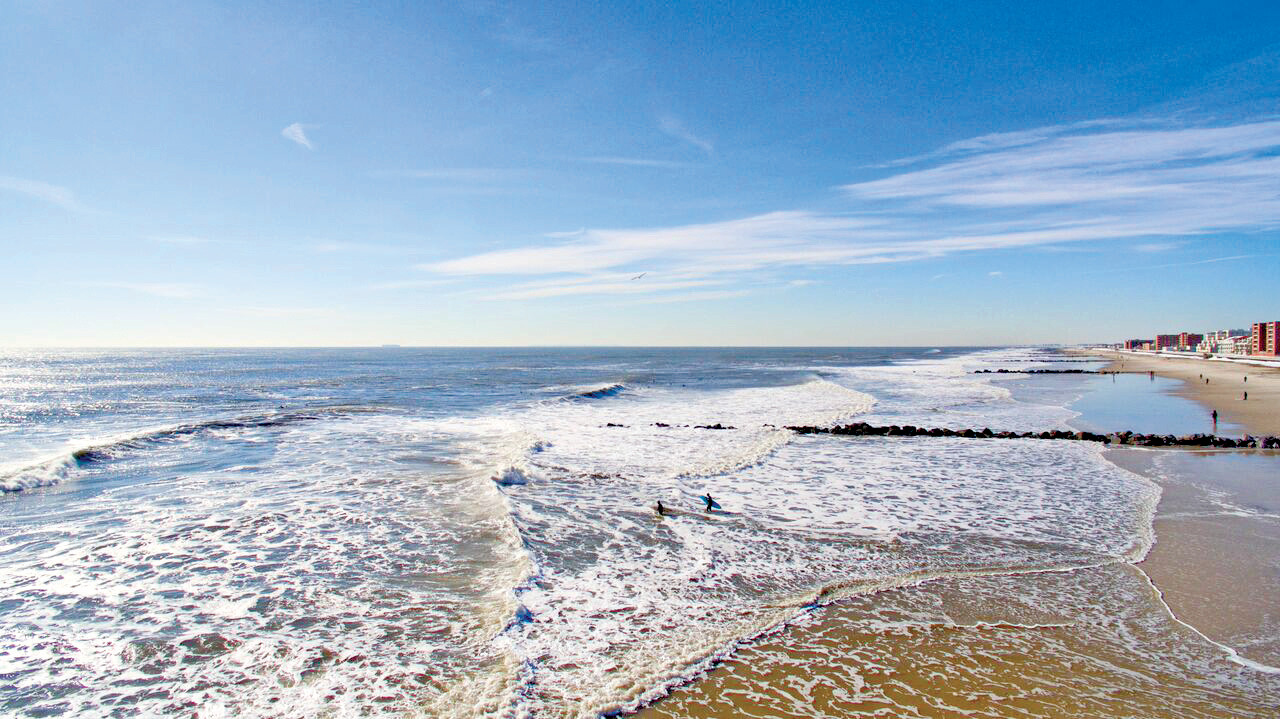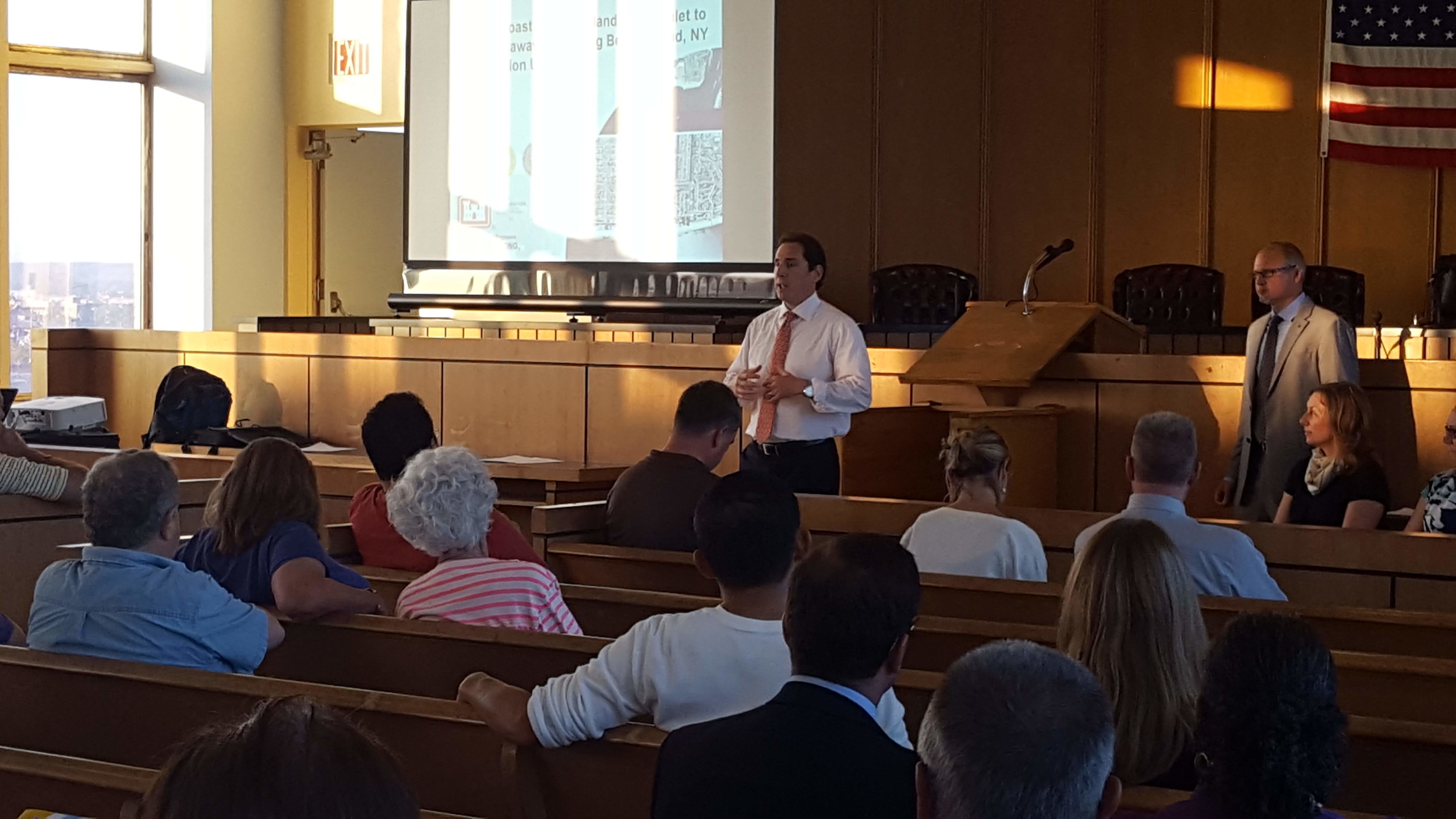Army Corps project begins this month
Work will start in Point Lookout and expand to Long Beach next year

Trucks will begin hauling 250,000 tons of large stones through the West End and the city this month as the Army Corps of Engineers begins work on a large-scale coastal protection project that includes rebuilding jetties and constructing a system of dunes and berms from Long Beach to Point Lookout.
U.S. Rep. Kathleen Rice, State Sen. Todd Kaminsky, County Legislator Denise Ford and city officials held a meeting with corps representatives in Long Beach on June 29 to update residents about the upcoming work schedule. The project will begin in Point Lookout and Lido Beach this month, and work in Long Beach will start next year.
“You can imagine what it means to have trucks full of stone pull into Point Lookout every day, many of them multiple times a day, so people there are very concerned,” said Kaminsky, who had hosted a meeting in Point Lookout a day earlier. “ … [T]his is not anything that is set in stone … it is important that [the Army Corps] have your input, and then we will adjust where it’s deemed … appropriate. Obviously, some people are going to be impacted by this more than others.”
The $230 million project calls for the rehabilitation of 17 existing jetties, or groins, and construction of four new ones, as well as the addition of roughly 4.7 million cubic yards of sand for a system of berms and dunes along 35,000 feet of shoreline.
The berm, dune and groin system is designed to protect seven of the nine miles of public shoreline between Jones Inlet and East Rockaway Inlet from a 100-year storm — from the east end of Point Lookout to Nevada Avenue in Long Beach. The project will taper off in East Atlantic Beach, because it does not include the Village of Atlantic Beach.
“The entire project is pretty much a monster,” said Dan Falt, a project manager with the Army Corps. “It’s a lot of work, and it’s going to take a few years. When the project is done there’ll be a continuous dune line, from Point Lookout all the way to [East] Atlantic Beach, with no breaks, no openings, but a contiguous line of protection.”
Hurricane Sandy decimated the city’s shoreline — the beach lost 294,000 cubic yards of sand — and officials contend that the project is crucial. Once it is completed, if another storm were to damage the beach, the city would be eligible for emergency rehabilitation funding to replace the sand.
“The Army Corps project is long overdue, and it will help ensure that we have a stronger, smarter and safer beach,” City Manager Jack Schnirman said. “It is extremely important to the City Council that the entire process be transparent, and that the community is involved every step of the way.”
In March, the Army Corps awarded Bay Shore-based H&L Construction a $38 million contract to start work on the groins, which is expected to take two years.
Trucks will use the Atlantic Beach Bridge to transport rocks from New Jersey; a team of 20 tractor-trailers or flatbed trucks will make two trips per day Monday through Friday, between 7 a.m. and 3:30 p.m., using Park Avenue or East Broadway, and several large payloaders and other construction vehicles will do the work on the beach. There will be no work on weekends or holidays.
“When these trucks arrive, they’re not quiet — there is noise,” Falt said.
Fifteen existing groins in Long Beach and two in Point Lookout will be rehabilitated, and four new groins will be built at Point Lookout’s Town Park.
There will be no work in Point Lookout and Lido between April and September 2017. Work on the Long Beach groins will begin on Georgia Avenue next August, and finish at Roosevelt Boulevard in July 2018. The work will be year-round, except in the summer at National, Edwards and Riverside boulevards. Two groins will be under construction at a time, and those areas will be closed. Each groin will take about a month to complete, and sections of the beach will reopen as construction moves along.
Resident Scott Bochner and others asked why the stones couldn’t be transported by barge, and Ford asked about alternative truck routes, saying that a county road project is set to begin next year in Atlantic Beach and will overlap with the Army Corps work.
Lynn Bocamazo, a chief engineer for the Army Corps, said that the agency had looked into using barges but did not find any suitable locations for a temporary pier, aside from one in Point Lookout. “The contractor could have used that location, and he chose not to,” she said. “We understand that maybe it’s not optimal to have these trucks.”
A second contract will be awarded in November 2017 for the work on the dunes and berms, which will also take about two years. The plan calls for 25-foot-wide dunes in Long Beach that would rise to a height of 14 feet nearest the boardwalk. They would slope down to a 40-foot-wide berm at an elevation of 9 feet, and a 130-foot-wide berm 2 feet lower that would slope down to the waterline. The project would include 31 dune crossovers in Long Beach alone, and the dunes would connect with those already in place at Nickerson Beach and in the city’s West End.
A number of residents also asked about the quality of sand that would be pumped onto the beach, access to the beach during the work and erosion.
“If the quality of the sand on the beach in Long Beach … is, all of a sudden, similar to what the North Shore of Long Island is, it will have a major economic impact to Long Beach and the barrier island,” one resident said.
The corps plans to use sand dredged a mile off Long Beach, officials said, and the new sand will be “comparable” to the existing beach.

 39.0°,
Fair
39.0°,
Fair 








